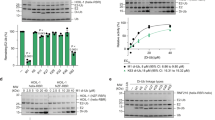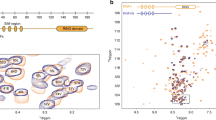Abstract
The conjugation of small ubiquitin-like modifiers SUMO-1, SUMO-2 and SUMO-3 onto target proteins requires the concerted action of the specific E1-activating enzyme SAE1/SAE2, the E2-conjugating enzyme Ubc9, and an E3-like SUMO ligase. NMR chemical shift perturbation was used to identify the surface of Ubc9 that interacts with the SUMO ligase RanBP2. Unlike known ubiquitin E2-E3 interactions, RanBP2 binds to the β-sheet of Ubc9. Mutational disruption of Ubc9-RanBP2 binding affected SUMO-2 but not SUMO-1 conjugation to Sp100 and to a newly identified RanBP2 substrate, PML. RanBP2 contains a binding site specific for SUMO-1 but not SUMO-2, indicating that a Ubc9–SUMO-1 thioester could be recruited to RanBP2 via SUMO-1 in the absence of strong binding between Ubc9 and RanBP2. Thus we show that E2-E3 interactions are not conserved across the ubiquitin-like protein superfamily and identify a RanBP2-dependent mechanism for SUMO paralog–specific conjugation.
This is a preview of subscription content, access via your institution
Access options
Subscribe to this journal
Receive 12 print issues and online access
$189.00 per year
only $15.75 per issue
Buy this article
- Purchase on Springer Link
- Instant access to full article PDF
Prices may be subject to local taxes which are calculated during checkout






Similar content being viewed by others
References
Saitoh, H. & Hinchey, J. Functional heterogeneity of small ubiquitin-related protein modifiers SUMO-1 versus SUMO-2/3. J. Biol. Chem. 275, 6252–6258 (2000).
Tatham, M.H. et al. Polymeric chains of SUMO-2 and SUMO-3 are conjugated to protein substrates by SAE1/SAE2 and Ubc9. J. Biol. Chem. 276, 35368–35374 (2001).
Tatham, M.H. & Hay, R.T. Ubiquitin and ubiquitin-like modifiers: conserved mechanisms and diverse functions. Chemtracts Biochem. Mol. Biol. 16, 759–782 (2003).
Seeler, J.S. & Dejean, A. Nuclear and unclear functions of SUMO. Nat. Rev. Mol. Cell. Biol. 4, 690–699 (2003).
Melchior, F., Schergaut, M. & Pichler, A. SUMO: ligases, isopeptidases and nuclear pores. Trends Biochem. Sci. 28, 612–618 (2003).
Hershko, A. & Ciechanover, A. The ubiquitin system. Annu. Rev. Biochem. 67, 425–479 (1998).
Johnson, E.S. & Gupta, A.A. An E3-like factor that promotes SUMO conjugation to the yeast septins. Cell 106, 735–744 (2001).
Takahashi, Y., Toh-e, A. & Kikuchi, Y. A novel factor required for the SUMO1/Smt3 conjugation of yeast septins. Gene 275, 223–231 (2001).
Kotaja, N., Karvonen, U., Janne, O.A. & Palvimo, J.J. PIAS proteins modulate transcription factors by functioning as SUMO-1 ligases. Mol. Cell. Biol. 22, 5222–5234 (2002).
Nishida, T. & Yasuda, H. PIAS1 and PIASxα function as SUMO-E3 ligases toward androgen receptor and repress androgen receptor-dependent transcription. J. Biol. Chem. 277, 41311–41317 (2002).
Huang, L. et al. Structure of an E6AP-UbcH7 complex: insights into ubiquitination by the E2-E3 enzyme cascade. Science 286, 1321–1326 (1999).
Zheng, N., Wang, P., Jeffrey, P.D. & Pavletich, N.P. Structure of a c-Cbl-UbcH7 complex: RING domain function in ubiquitin-protein ligases. Cell 102, 533–539 (2000).
Pichler, A., Gast, A., Seeler, J.S., Dejean, A. & Melchior, F. The nucleoporin RanBP2 has SUMO1 E3 ligase activity. Cell 108, 109–120 (2002).
Liu, Q. et al. The binding interface between an E2 (UBC9) and a ubiquitin homologue (UBL1). J. Biol. Chem. 274, 16979–16987 (1999).
Ohi, M.D., Vander Kooi, C.W., Rosenberg, J.A., Chazin, W.J. & Gould, K.L. Structural insights into the U-box, a domain associated with multi-ubiquitination. Nat. Struct. Biol. 10, 250–255 (2003).
Tatham, M.H. et al. Role of an N-terminal site of Ubc9 in SUMO-1, -2, and -3 binding and conjugation. Biochemistry 42, 9959–9969 (2003).
Yokoyama, N. et al. A giant nucleopore protein that binds Ran/TC4. Nature 376, 184–188 (1995).
Pichler, A., Knipscheer, P., Saitoh, H., Sixma, T.K. & Melchior, F. The RanBP2 SUMO E3 ligase is neither HECT- nor RING-type. Nat. Struct. Mol. Biol. 11, 984–991 (2004).
Jentsch, S. The ubiquitin-conjugation system. Annu. Rev. Genet. 26, 179–207 (1992).
Bencsath, K.P., Podgorski, M.S., Pagala, V.R., Slaughter, C.A. & Schulman, B.A. Identification of a multifunctional binding site on Ubc9p required for Smt3p conjugation. J. Biol. Chem. 277, 47938–47945 (2002).
Saitoh, H., Pizzi, M.D. & Wang, J. Perturbation of SUMOlation enzyme Ubc9 by distinct domain within nucleoporin RanBP2/Nup358. J. Biol. Chem. 277, 4755–4763 (2002).
Song, J., Durrin, L.K., Wilkinson, T.A., Krontiris, T.G. & Chen, Y. Identification of a SUMO-binding motif that recognizes SUMO-modified proteins. Proc. Natl. Acad. Sci. USA 101, 14373–14378 (2004).
Canning, M., Boutell, C., Parkinson, J. & Everett, R.D. A RING finger ubiquitin ligase is protected from autocatalyzed ubiquitination and degradation by binding to ubiquitin-specific protease USP7. J. Biol. Chem. 279, 38160–38168 (2004).
Wu, X., Yen, L., Irwin, L., Sweeney, C. & Carraway, K.L., 3rd. Stabilization of the E3 ubiquitin ligase Nrdp1 by the deubiquitinating enzyme USP8. Mol. Cell. Biol. 24, 7748–7757 (2004).
Siepmann, T.J., Bohnsack, R.N., Tokgoz, Z., Baboshina, O.V. & Haas, A.L. Protein interactions within the N-end rule ubiquitin ligation pathway. J. Biol. Chem. 278, 9448–9457 (2003).
Sachdev, S. et al. PIASy, a nuclear matrix-associated SUMO E3 ligase, represses LEF1 activity by sequestration into nuclear bodies. Genes Dev. 15, 3088–3103 (2001).
Desterro, J.M., Thomson, J. & Hay, R.T. Ubch9 conjugates SUMO but not ubiquitin. FEBS Lett. 417, 297–300 (1997).
Jaffray, E., Wood, K.M. & Hay, R.T. Domain organization of IκBα and sites of interaction with NF-κB p65. Mol. Cell. Biol. 15, 2166–2172 (1995).
Pervushin, K. Impact of transverse relaxation optimized spectroscopy (TROSY) on NMR as a technique in structural biology. Q. Rev. Biophys. 33, 161–197 (2000).
Giraud, M.F., Desterro, J.M. & Naismith, J.H. Structure of ubiquitin-conjugating enzyme 9 displays significant differences with other ubiquitin-conjugating enzymes which may reflect its specificity for sumo rather than ubiquitin. Acta Crystallogr. D. 54, 891–898 (1998).
Tong, H., Hateboer, G., Perrakis, A., Bernards, R. & Sixma, T.K. Crystal structure of murine/human Ubc9 provides insight into the variability of the ubiquitin-conjugating system. J. Biol. Chem. 272, 21381–21387 (1997).
Acknowledgements
We thank G. Kemp (University of St. Andrews) for help with RanBP2 binding studies. This work was supported by the UK Medical Research Council, the Association for International Cancer Research (M.H.T. and R.T.H.) and US National Institutes of Health grant numbers GM 59887 and CA 94595 (Y.C.).
Author information
Authors and Affiliations
Corresponding author
Ethics declarations
Competing interests
The authors declare no competing financial interests.
Supplementary information
Supplementary Fig. 1
Gel filtration chromatographic analysis of RanBP2–Ubc9 mutant complexes. (PDF 1129 kb)
Supplementary Fig. 2
Gel filtration chromatographic analysis of RanBP2–SUMO complexes. (PDF 907 kb)
Rights and permissions
About this article
Cite this article
Tatham, M., Kim, S., Jaffray, E. et al. Unique binding interactions among Ubc9, SUMO and RanBP2 reveal a mechanism for SUMO paralog selection. Nat Struct Mol Biol 12, 67–74 (2005). https://doi.org/10.1038/nsmb878
Received:
Accepted:
Published:
Issue Date:
DOI: https://doi.org/10.1038/nsmb878
This article is cited by
-
The SUMO–NIP45 pathway processes toxic DNA catenanes to prevent mitotic failure
Nature Structural & Molecular Biology (2023)
-
Functional 3D architecture in an intrinsically disordered E3 ligase domain facilitates ubiquitin transfer
Nature Communications (2020)
-
Noncovalent SUMO-interaction motifs in HIV integrase play important roles in SUMOylation, cofactor binding, and virus replication
Virology Journal (2019)
-
PML: Regulation and multifaceted function beyond tumor suppression
Cell & Bioscience (2018)
-
Molecular mechanism of K65 acetylation-induced attenuation of Ubc9 and the NDSM interaction
Scientific Reports (2017)



